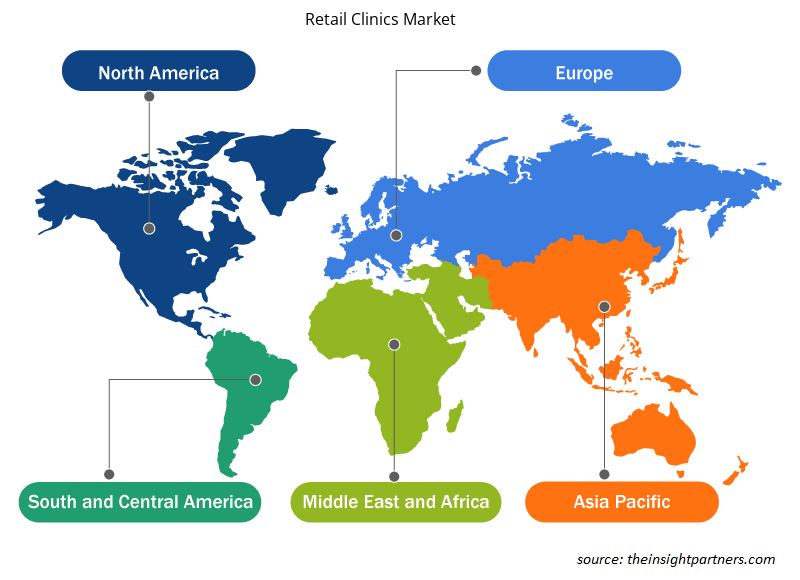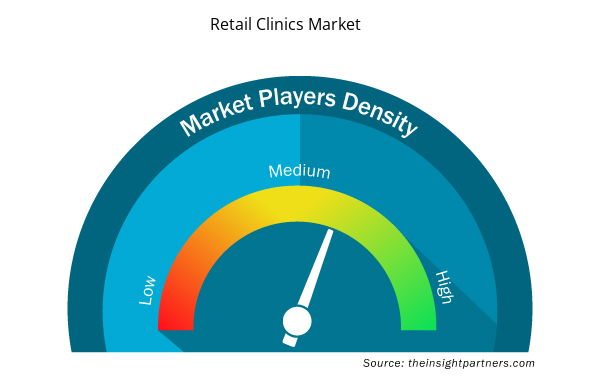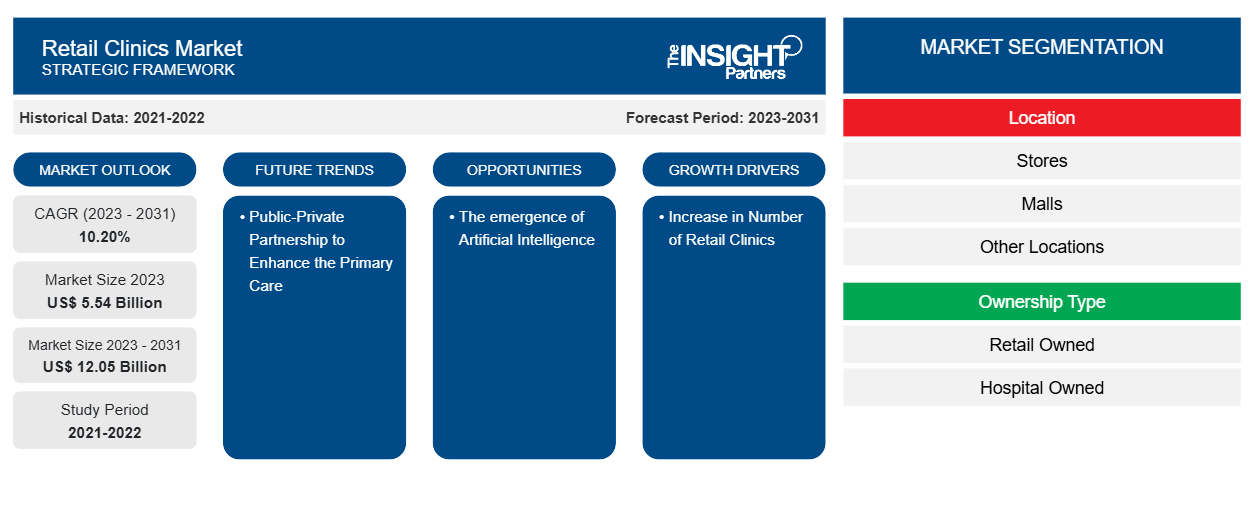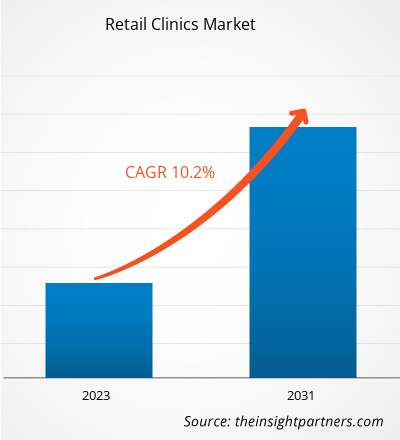Si prevede che la dimensione del mercato delle cliniche al dettaglio raggiungerà i 12,05 miliardi di dollari entro il 2031, rispetto ai 5,54 miliardi di dollari del 2023. Si prevede che il mercato registrerà un CAGR del 10,20% nel 2023-2031. È probabile che l'emergere dell'intelligenza artificiale rimanga una tendenza chiave del mercato delle cliniche al dettaglio.
Analisi di mercato delle cliniche al dettaglio
Le cliniche al dettaglio sono state suggerite come alternativa più economica alle cure del pronto soccorso per condizioni non urgenti. Fino al 20 percento delle visite al pronto soccorso per contesti non urgenti sono considerate appropriate per le cliniche al dettaglio o le strutture di cure urgenti, con un potenziale risparmio di costi fino a 4,4 miliardi di dollari all'anno. Nel settore sanitario, le cliniche al dettaglio stanno diventando sempre più critiche. Prezzi trasparenti e accessibilità fuori orario sono i principali fattori che influenzano la crescita.
Panoramica del mercato delle cliniche al dettaglio
L'applicazione dell'intelligenza artificiale (IA) nell'assistenza sanitaria, comprese le cliniche al dettaglio, è in crescita. L'IA può aiutare con la pianificazione degli appuntamenti, il triage dei pazienti e il supporto alle decisioni dei medici. Le cliniche possono migliorare la soddisfazione dei pazienti, ridurre gli oneri amministrativi e semplificare le operazioni con l'uso di questa tecnologia. In risposta alle mutevoli esigenze dell'assistenza sanitaria, le cliniche al dettaglio stanno iniziando a fornire servizi più specializzati come la gestione delle malattie croniche e il supporto alla salute mentale. I fattori sopra menzionati influenzano la crescita del mercato delle cliniche al dettaglio
Personalizza questo report in base alle tue esigenze
Riceverai la personalizzazione gratuita di qualsiasi report, comprese parti di questo report, o analisi a livello nazionale, pacchetto dati Excel, oltre a usufruire di grandi offerte e sconti per start-up e università
- Scopri le principali tendenze di mercato in questo rapporto.Questo campione GRATUITO includerà analisi di dati che spaziano dalle tendenze di mercato alle stime e alle previsioni.
Driver e opportunità di mercato per le cliniche al dettaglio
L'aumento del numero di cliniche al dettaglio favorisce il mercato
La casa medica incentrata sul paziente sta guadagnando popolarità come mezzo per offrire un'assistenza primaria completa e ben gestita. La quantità di cliniche al dettaglio è notevolmente aumentata contemporaneamente. È stato dimostrato un crescente supporto per la casa medica incentrata sul paziente per coordinare meglio l'assistenza, migliorare la qualità, risparmiare sui costi e dare nuova vita all'assistenza primaria. Il numero di cliniche al dettaglio che forniscono assistenza accessibile per malattie acute minori è aumentato drasticamente e il concetto di casa medica ha guadagnato popolarità. Pertanto, un aumento della popolarità delle cliniche al dettaglio porta a un aumento del numero di cliniche, guidando così la crescita del mercato. Ad esempio, secondo Definitive Healthcare, LLC., a marzo 2023, 1.801 cliniche al dettaglio operative erano distribuite in 44 stati. Il Midwest (27,7%) e il Sud-est (34,1%) ospitano la maggior parte delle cliniche al dettaglio negli Stati Uniti. Ci sono il minor numero di cliniche al dettaglio nell'Occidente (9,5%).
Partenariato pubblico-privato per migliorare l’assistenza primaria: un’opportunità nel mercato delle cliniche al dettaglio
I comuni e i governi statali possono migliorare l'accesso alle cure primarie e promuovere lo sviluppo economico collaborando con rivenditori e cliniche al dettaglio attraverso partnership pubblico-private. Ad esempio, a febbraio 2024, tramite il Rapid Response Partnership Vehicle (RRPV), BARDA ha annunciato una nuova opportunità di partnership Project NextGen volta a facilitare una migliore raccolta di dati sul correlato di protezione (CoP) del vaccino e ad accelerare le soluzioni di sperimentazione clinica decentralizzata (DCT). BARDA sta cercando un partner per il suo primo studio clinico, che verrà condotto solo in una clinica al dettaglio o in una farmacia.
Analisi della segmentazione del rapporto di mercato delle cliniche al dettaglio
I segmenti chiave che hanno contribuito alla derivazione dell'analisi di mercato delle cliniche al dettaglio sono la posizione, il tipo di proprietà e l'applicazione.
- In base alla posizione, il mercato delle cliniche al dettaglio è suddiviso in negozi, centri commerciali e altre sedi. Il segmento dei negozi ha detenuto una quota di mercato maggiore nel 2023.
- In base al tipo di proprietà, il mercato è segmentato in proprietà di rivenditori al dettaglio e proprietà di ospedali.
- In termini di applicazione, il mercato è segmentato in chimica clinica e immunoanalisi, diagnostica point-of-care, vaccinazioni e altre applicazioni.
Analisi della quota di mercato delle cliniche al dettaglio per area geografica
L'ambito geografico del rapporto di mercato sulle cliniche al dettaglio è suddiviso principalmente in cinque regioni: Nord America, Asia Pacifico, Europa, Medio Oriente e Africa e Sud America/Sud e Centro America.
In Nord America, il mercato delle cliniche al dettaglio è attualmente in fase di crescita e sta vivendo una crescita esponenziale. Gli Stati Uniti hanno dominato il mercato nel 2023 grazie alla crescente popolarità e disponibilità delle cliniche al dettaglio. Ad esempio, CVS, Walgreens e Walmart sono le principali cliniche al dettaglio disponibili negli Stati Uniti. Sei gruppi controllano il novanta percento delle cliniche al dettaglio. Con oltre la metà di tutti i siti di cliniche al dettaglio, il player più importante della nazione è il gigante della farmacia CVS. L'azienda, che possiede anche un gestore di benefit farmaceutici (Caremark) e un pagatore (Aetna), è entrata nel settore delle cliniche al dettaglio nel 2006 quando ha acquistato MinuteClinic, precedentemente QuickMedx.
Approfondimenti regionali sul mercato delle cliniche al dettaglio
Le tendenze regionali e i fattori che influenzano il mercato delle cliniche al dettaglio durante il periodo di previsione sono stati ampiamente spiegati dagli analisti di Insight Partners. Questa sezione discute anche i segmenti e la geografia del mercato delle cliniche al dettaglio in Nord America, Europa, Asia Pacifico, Medio Oriente e Africa e America centrale e meridionale.

- Ottieni i dati specifici regionali per il mercato delle cliniche al dettaglio
Ambito del rapporto di mercato sulle cliniche al dettaglio
| Attributo del report | Dettagli |
|---|---|
| Dimensioni del mercato nel 2023 | 5,54 miliardi di dollari USA |
| Dimensioni del mercato entro il 2031 | 12,05 miliardi di dollari USA |
| CAGR globale (2023-2031) | 10,20% |
| Dati storici | 2021-2022 |
| Periodo di previsione | 2023-2031 |
| Segmenti coperti | Per posizione
|
| Regioni e Paesi coperti | America del Nord
|
| Leader di mercato e profili aziendali chiave |
|
Densità degli attori del mercato: comprendere il suo impatto sulle dinamiche aziendali
Il mercato delle cliniche al dettaglio sta crescendo rapidamente, spinto dalla crescente domanda degli utenti finali dovuta a fattori quali l'evoluzione delle preferenze dei consumatori, i progressi tecnologici e una maggiore consapevolezza dei benefici del prodotto. Con l'aumento della domanda, le aziende stanno ampliando le loro offerte, innovando per soddisfare le esigenze dei consumatori e capitalizzando sulle tendenze emergenti, il che alimenta ulteriormente la crescita del mercato.
La densità degli operatori di mercato si riferisce alla distribuzione di aziende o società che operano in un particolare mercato o settore. Indica quanti concorrenti (operatori di mercato) sono presenti in un dato spazio di mercato in relazione alle sue dimensioni o al valore di mercato totale.
Le principali aziende che operano nel mercato delle cliniche al dettaglio sono:
- La Kroger Co.
- Salute CVS
- Corporazione Rite Aid
- Società a responsabilità limitata
- Azienda Walgreens
- Società controllata da Nextcare Holdings, Inc.
Disclaimer : le aziende elencate sopra non sono classificate secondo un ordine particolare.

- Ottieni una panoramica dei principali attori del mercato delle cliniche al dettaglio
Notizie di mercato e sviluppi recenti sulle cliniche al dettaglio
Il mercato delle cliniche al dettaglio viene valutato raccogliendo dati qualitativi e quantitativi dopo la ricerca primaria e secondaria, che include importanti pubblicazioni aziendali, dati associativi e database. Di seguito è riportato un elenco degli sviluppi nel mercato per innovazioni, espansione aziendale e strategie:
- Nell'ottobre 2023, Walgreens e Hartford HealthCare aggiungeranno cliniche sanitarie a sedi Walgreens selezionate nel Connecticut, promuovendo un modello sanitario al dettaglio unico basato su convenienza, accesso alle cure, convenienza ed equità sanitaria. Questa è la prima collaborazione di Walgreens con una clinica al dettaglio con un sistema sanitario nel New England. (Fonte: Hartford HealthCare, comunicato stampa)
Copertura e risultati del rapporto di mercato sulle cliniche al dettaglio
Il rapporto "Dimensioni e previsioni del mercato delle cliniche al dettaglio (2021-2031)" fornisce un'analisi dettagliata del mercato che copre le seguenti aree:
Dimensioni e previsioni del mercato delle cliniche al dettaglio a livello globale, regionale e nazionale per tutti i segmenti di mercato chiave coperti dall'ambito
- Dinamiche di mercato come fattori trainanti, vincoli e opportunità chiave
Tendenze del mercato delle cliniche al dettaglio
- Analisi dettagliata delle cinque forze PEST/Porter e SWOT
Analisi di mercato delle cliniche al dettaglio che copre le principali tendenze del mercato, il quadro globale e regionale, i principali attori, le normative e i recenti sviluppi del mercato
Analisi del panorama del settore delle cliniche al dettaglio e della concorrenza che copre la concentrazione del mercato, l'analisi della mappa di calore, i principali attori e gli sviluppi recenti
- Profili aziendali dettagliati
- Analisi storica (2 anni), anno base, previsione (7 anni) con CAGR
- Analisi PEST e SWOT
- Valore/volume delle dimensioni del mercato - Globale, regionale, nazionale
- Industria e panorama competitivo
- Set di dati Excel


- Cosmetic Bioactive Ingredients Market
- Hydrogen Storage Alloys Market
- Military Rubber Tracks Market
- Photo Editing Software Market
- Nuclear Decommissioning Services Market
- Trade Promotion Management Software Market
- Clinical Trial Supplies Market
- Environmental Consulting Service Market
- Customer Care BPO Market
- UV Curing System Market

Report Coverage
Revenue forecast, Company Analysis, Industry landscape, Growth factors, and Trends

Segment Covered
This text is related
to segments covered.

Regional Scope
North America, Europe, Asia Pacific, Middle East & Africa, South & Central America

Country Scope
This text is related
to country scope.
Domande frequenti
North America dominated the retail clinics market in 2023
The increase in the number of retail clinics and the surge in the prevalence of chronic diseases has been boosting the market growth of retail clinics over the years.
The emergence of AI is likely to remain a key trend in the market.
The Kroger Co., CVS Health, Rite Aid Corp, Walmart Inc., Walgreens co., Nextcare Holdings, Inc., MedExpress, Doctors care, Bellin Health Systems, and Concentra, Inc.
The market is expected to register a CAGR of 10.20% during 2023–2031.
Trends and growth analysis reports related to Life Sciences : READ MORE..
The Insight Partners performs research in 4 major stages: Data Collection & Secondary Research, Primary Research, Data Analysis and Data Triangulation & Final Review.
- Data Collection and Secondary Research:
As a market research and consulting firm operating from a decade, we have published and advised several client across the globe. First step for any study will start with an assessment of currently available data and insights from existing reports. Further, historical and current market information is collected from Investor Presentations, Annual Reports, SEC Filings, etc., and other information related to company’s performance and market positioning are gathered from Paid Databases (Factiva, Hoovers, and Reuters) and various other publications available in public domain.
Several associations trade associates, technical forums, institutes, societies and organization are accessed to gain technical as well as market related insights through their publications such as research papers, blogs and press releases related to the studies are referred to get cues about the market. Further, white papers, journals, magazines, and other news articles published in last 3 years are scrutinized and analyzed to understand the current market trends.
- Primary Research:
The primarily interview analysis comprise of data obtained from industry participants interview and answers to survey questions gathered by in-house primary team.
For primary research, interviews are conducted with industry experts/CEOs/Marketing Managers/VPs/Subject Matter Experts from both demand and supply side to get a 360-degree view of the market. The primary team conducts several interviews based on the complexity of the markets to understand the various market trends and dynamics which makes research more credible and precise.
A typical research interview fulfils the following functions:
- Provides first-hand information on the market size, market trends, growth trends, competitive landscape, and outlook
- Validates and strengthens in-house secondary research findings
- Develops the analysis team’s expertise and market understanding
Primary research involves email interactions and telephone interviews for each market, category, segment, and sub-segment across geographies. The participants who typically take part in such a process include, but are not limited to:
- Industry participants: VPs, business development managers, market intelligence managers and national sales managers
- Outside experts: Valuation experts, research analysts and key opinion leaders specializing in the electronics and semiconductor industry.
Below is the breakup of our primary respondents by company, designation, and region:

Once we receive the confirmation from primary research sources or primary respondents, we finalize the base year market estimation and forecast the data as per the macroeconomic and microeconomic factors assessed during data collection.
- Data Analysis:
Once data is validated through both secondary as well as primary respondents, we finalize the market estimations by hypothesis formulation and factor analysis at regional and country level.
- Macro-Economic Factor Analysis:
We analyse macroeconomic indicators such the gross domestic product (GDP), increase in the demand for goods and services across industries, technological advancement, regional economic growth, governmental policies, the influence of COVID-19, PEST analysis, and other aspects. This analysis aids in setting benchmarks for various nations/regions and approximating market splits. Additionally, the general trend of the aforementioned components aid in determining the market's development possibilities.
- Country Level Data:
Various factors that are especially aligned to the country are taken into account to determine the market size for a certain area and country, including the presence of vendors, such as headquarters and offices, the country's GDP, demand patterns, and industry growth. To comprehend the market dynamics for the nation, a number of growth variables, inhibitors, application areas, and current market trends are researched. The aforementioned elements aid in determining the country's overall market's growth potential.
- Company Profile:
The “Table of Contents” is formulated by listing and analyzing more than 25 - 30 companies operating in the market ecosystem across geographies. However, we profile only 10 companies as a standard practice in our syndicate reports. These 10 companies comprise leading, emerging, and regional players. Nonetheless, our analysis is not restricted to the 10 listed companies, we also analyze other companies present in the market to develop a holistic view and understand the prevailing trends. The “Company Profiles” section in the report covers key facts, business description, products & services, financial information, SWOT analysis, and key developments. The financial information presented is extracted from the annual reports and official documents of the publicly listed companies. Upon collecting the information for the sections of respective companies, we verify them via various primary sources and then compile the data in respective company profiles. The company level information helps us in deriving the base number as well as in forecasting the market size.
- Developing Base Number:
Aggregation of sales statistics (2020-2022) and macro-economic factor, and other secondary and primary research insights are utilized to arrive at base number and related market shares for 2022. The data gaps are identified in this step and relevant market data is analyzed, collected from paid primary interviews or databases. On finalizing the base year market size, forecasts are developed on the basis of macro-economic, industry and market growth factors and company level analysis.
- Data Triangulation and Final Review:
The market findings and base year market size calculations are validated from supply as well as demand side. Demand side validations are based on macro-economic factor analysis and benchmarks for respective regions and countries. In case of supply side validations, revenues of major companies are estimated (in case not available) based on industry benchmark, approximate number of employees, product portfolio, and primary interviews revenues are gathered. Further revenue from target product/service segment is assessed to avoid overshooting of market statistics. In case of heavy deviations between supply and demand side values, all thes steps are repeated to achieve synchronization.
We follow an iterative model, wherein we share our research findings with Subject Matter Experts (SME’s) and Key Opinion Leaders (KOLs) until consensus view of the market is not formulated – this model negates any drastic deviation in the opinions of experts. Only validated and universally acceptable research findings are quoted in our reports.
We have important check points that we use to validate our research findings – which we call – data triangulation, where we validate the information, we generate from secondary sources with primary interviews and then we re-validate with our internal data bases and Subject matter experts. This comprehensive model enables us to deliver high quality, reliable data in shortest possible time.


 Ottieni un campione gratuito per questo repot
Ottieni un campione gratuito per questo repot